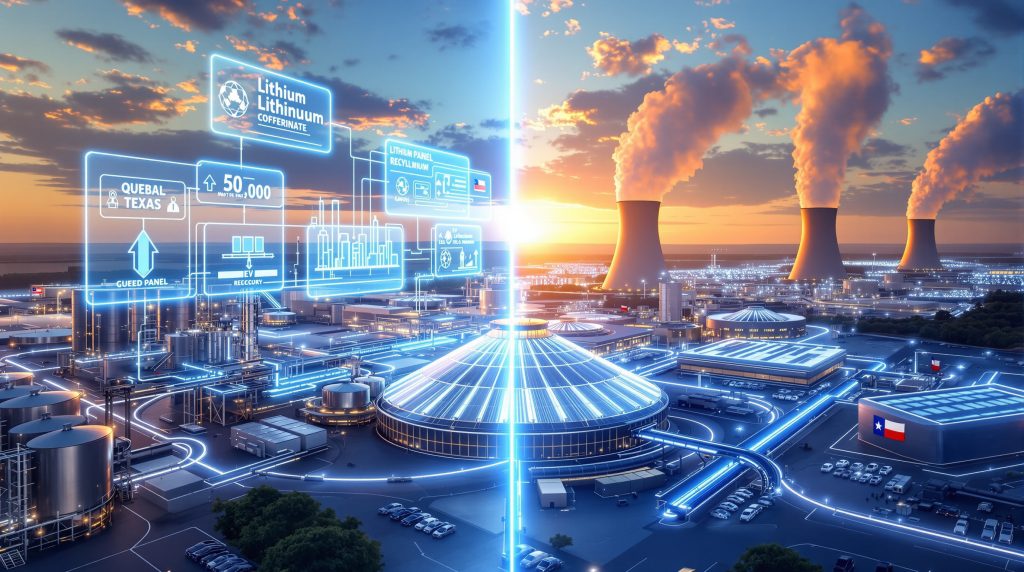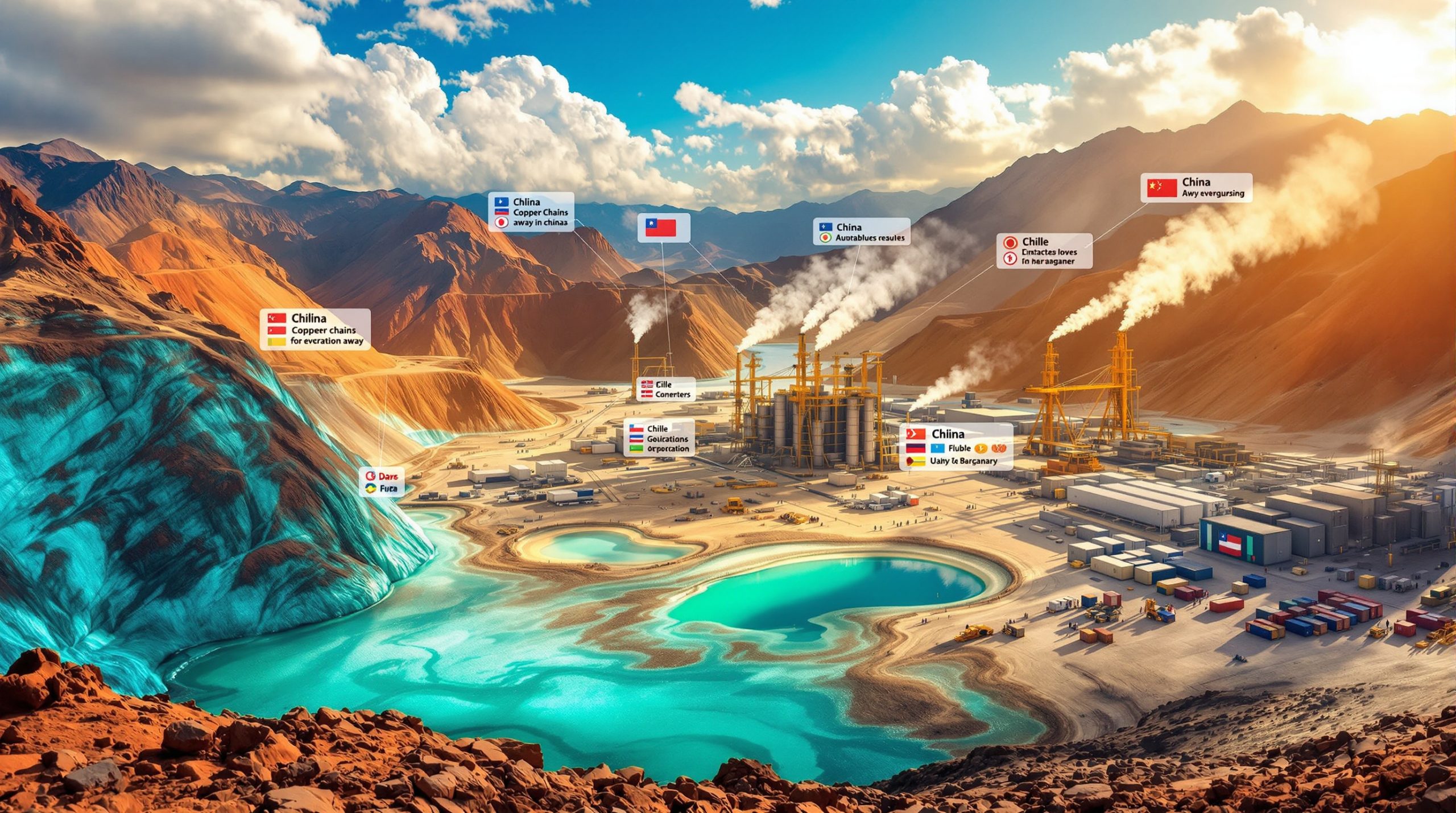The Future of Battery Metal Refining: Lithium Universe's Strategic Expansion
What is a Battery Metal Refinery and Why is it Critical for the EV Supply Chain?
Battery metal refineries serve as the crucial bridge between raw material extraction and battery manufacturing, transforming crude lithium concentrates into battery-grade chemicals essential for electric vehicle production. These specialized facilities convert raw lithium materials into high-purity lithium carbonate or hydroxide that meets the stringent quality requirements for modern lithium-ion batteries.
The refining stage represents one of the most critical bottlenecks in the entire battery supply chain. According to the U.S. Geological Survey's 2023 report, China controlled approximately 60-65% of global lithium refining capacity, highlighting the strategic importance of developing alternative processing hubs.
Battery-grade lithium refining must achieve extraordinary purity levels – typically 99.5% or higher for lithium carbonate with impurities below 100-150 parts per million. This exacting standard requires sophisticated processing technology and deep technical expertise that few companies possess globally.
Without adequate domestic refining capacity, even countries with abundant lithium resources remain dependent on overseas processing, creating vulnerabilities in supply chains critical for the clean energy transition.
How Does Lithium Universe's Quebec Refinery Technology Work?
The Proven Processing Technology
Lithium Universe's flagship Quebec facility employs a multi-stage refining process that transforms spodumene concentrate into battery-grade lithium carbonate. The process begins with calcination at temperatures between 1,000-1,100°C to convert the crystalline structure of the mineral, a critical first step that makes the lithium accessible for extraction.
Following calcination, the material undergoes sulfuric acid leaching to dissolve the lithium content into solution. This creates a lithium-rich liquid that requires multiple purification stages to eliminate metallic impurities that would compromise battery performance if present in the final product.
The purification process involves a series of chemical reactions and filtration steps designed to selectively remove contaminants while retaining the valuable lithium. The final stages include precipitation and crystallization of lithium carbonate followed by final purification to achieve battery-grade specifications.
This methodology leverages Quebec's abundant hydroelectric power, which provides low-carbon energy at competitive rates of 5-7 cents per kWh for industrial users, according to Hydro-Québec's 2023 Annual Report.
Production Capacity and Output Specifications
The Quebec refinery targets production of approximately 18,000 tonnes per annum of battery-grade lithium carbonate. This output is particularly well-suited for Lithium Iron Phosphate (LFP) battery cathodes, which have gained significant market share in certain EV segments and energy storage applications.
According to BloombergNEF's "Battery Price Survey 2023," LFP batteries offer several distinct advantages over nickel-based alternatives:
- Superior thermal stability with runaway temperatures of 270°C versus 210°C for NMC chemistry
- Extended cycle life of 3,000-6,000 cycles compared to 1,000-2,000 for NMC batteries
- Lower production costs, averaging $95/kWh at pack level versus $115/kWh for NMC batteries
- Reduced dependency on constrained metals like cobalt and nickel
These characteristics have driven LFP chemistry to become the preferred choice for stationary energy storage and certain EV market segments where range requirements are moderate but longevity and safety are paramount.
Why is Lithium Universe Expanding to Texas?
Strategic Advantages of the Brownsville Location
Lithium Universe's proposed Texas refinery expansion leverages multiple strategic advantages that the Brownsville location offers:
Logistics Efficiency: The Port of Brownsville provides exceptional import capabilities, handling approximately 6 million short tons of cargo annually according to its 2022 Annual Report. Its 42-foot depth accommodates Panamax-class vessels, making it ideal for importing spodumene concentrate from global sources.
Market Access: The Texas location positions the refinery in close proximity to the rapidly expanding U.S. battery manufacturing ecosystem. As domestic battery production increases, having local refining capacity significantly reduces supply chain complexity and transportation costs.
Infrastructure Advantages: The site's location adjacent to Chemical Road and State Highway 48 provides efficient transportation access, while existing chemical industry infrastructure in the region offers potential synergies and resource sharing opportunities.
Energy Resources: Texas had 22.2 GW of utility-scale solar capacity as of Q4 2023 according to the U.S. Energy Information Administration, creating potential opportunities for renewable energy integration.
Business Environment: According to the Tax Foundation's "2024 State Business Tax Climate Index," Texas ranked 13th nationally for overall business tax climate, with no corporate income tax and no individual income tax, creating a favorable operating environment.
The Solar Panel Recycling Connection
The integration with solar panel recycling operations represents an innovative approach to resource efficiency and circular economy principles. This co-location strategy offers several strategic benefits:
- Shared infrastructure reduces capital requirements for both operations, enhancing project economics
- End-of-life solar panels contain recoverable silver, silicon, and other valuable materials that can be processed using similar technical expertise
- Chemical processing capabilities can be leveraged across both recycling and refining operations
- The combination addresses two critical clean energy supply chain challenges simultaneously
As solar installation growth continues, the volume of panels requiring recycling will increase substantially over the coming decades, creating a logical pairing with battery material processing.
How Does Domestic Refining Capacity Impact the Battery Supply Chain?
Reducing Supply Chain Vulnerabilities
North American battery metal refining capacity delivers several strategic advantages that strengthen the resilience of the entire supply chain:
| Benefit | Impact on Supply Chain |
|---|---|
| Geographic Diversification | Reduces concentration risk from Asia-dominated processing |
| Shipping Efficiency | Cuts carbon footprint by up to 0.5-1.0 tonnes CO₂ per tonne of material |
| Supply Security | Mitigates geopolitical and logistical disruption risks |
| Quality Control | Enables closer integration between refiners and battery producers |
| Innovation Acceleration | Shortens feedback loops for process and product improvements |
According to a Brookings Institution report from February 2023, geographic concentration of refining capacity creates significant supply chain vulnerabilities. The report notes that domestic processing reduces lead times from 6-8 weeks for Asian imports to just days for regional supply, enabling more responsive manufacturing.
The Economic Multiplier Effect
Battery metal refineries create substantial economic value beyond direct employment, functioning as anchors for broader industrial development:
- Creation of high-skilled technical positions in chemical processing, quality control, and process engineering
- Development of local supplier networks for reagents, equipment, and specialized services
- Attraction of downstream manufacturing including cathode, anode, and cell production facilities
- Formation of technical expertise clusters that can be applied to other critical mineral processing
The International Energy Agency's "Global EV Outlook 2023" report projected that North American lithium refining capacity would grow from approximately 50,000 tonnes in 2023 to 400,000-500,000 tonnes by 2030, representing a major shift in the global supply chain landscape.
What Technological Innovations are Advancing Battery Metal Refining?
Emerging Refining Technologies
The battery metal refining sector is experiencing rapid technological evolution as companies seek more efficient, sustainable, and cost-effective processing methods:
Direct lithium extraction: According to the U.S. Department of Energy's "Lithium-Ion Battery Supply Chain Review" from February 2022, DLE technologies can reduce water consumption by 90% compared to conventional evaporation ponds while increasing lithium recovery rates from 40-60% to 80-90%.
Electrochemical Processing: Research published in Nature Communications by Li et al. in March 2023 demonstrated selective lithium extraction using electrode materials at ambient temperature, reducing energy consumption from 2-3 MWh per tonne to 1.5-2.0 MWh while eliminating acid consumption in the primary extraction stage.
Modular Processing Systems: Scalable refining systems that can be deployed incrementally to match market growth are emerging as an alternative to traditional large-scale facilities, though commercial validation at scale remains limited.
Advanced Recovery Methods: Novel approaches for extracting lithium from unconventional sources including geothermal brines, oilfield produced water, and clay deposits are expanding the potential resource base.
Sustainability Improvements in Refining
Modern battery metal refineries are implementing numerous sustainability measures to reduce their environmental footprint:
- Water recycling systems achieving 80-95% recirculation rates according to the International Lithium Association's "Best Practices in Lithium Processing" (2023)
- Closed-loop battery recycling that reduces freshwater consumption to 2-4 cubic meters per tonne of lithium carbonate
- Energy efficiency improvements through heat recovery and process optimization
- Reagent recycling to minimize chemical consumption and waste generation
- By-product valorization creating additional revenue streams from materials previously treated as waste
These sustainability initiatives are becoming increasingly important as customers and investors place greater emphasis on environmental performance throughout the battery supply chain.
What Challenges Must Battery Metal Refineries Overcome?
Technical and Operational Hurdles
Battery metal refineries face several significant challenges that require sophisticated technical solutions:
Feedstock Variability: According to research published in Minerals Engineering by Zhang et al. (April 2023), spodumene concentrate quality varies from 5.5% to 7.5% Li₂O content depending on source, with iron contamination ranging from 0.5% to 2.5%. These variations require adaptive processing parameters to maintain consistent output quality.
Process Complexity: Managing chemical processes at industrial scale involves hundreds of variables that must be precisely controlled to achieve battery-grade specifications consistently.
Technical Expertise: The National Renewable Energy Laboratory's "Critical Minerals Workforce Study" (September 2023) found that lithium universe battery metal refinery facilities require 15-25 specialized chemical engineers and process technicians per 10,000 tonnes of annual capacity, with average training periods of 12-18 months.
Environmental Compliance: Meeting increasingly stringent regulations for air emissions, water discharge, and waste management requires sophisticated control systems and monitoring.
Market and Financial Considerations
The business case for refinery development must navigate several challenging market dynamics:
Price Volatility: Battery-grade lithium carbonate prices exhibited extreme volatility between 2020-2023, ranging from $7,000/tonne to $82,000/tonne according to Trading Economics data, creating significant uncertainty for project developers.
Capital Intensity: According to Wood Mackenzie's "Lithium Refinery Cost Curve Analysis" (August 2023), total installed capital costs average $18,000-$22,000 per tonne of annual capacity, representing substantial upfront investment.
Development Timelines: The Canadian Critical Minerals Association's "Project Development Guide" (2023) indicates typical development timelines of 48-84 months from initiation to steady-state production, spanning environmental permitting (12-24 months), engineering and design (12-18 months), construction (18-30 months), and commissioning (6-12 months).
Competitive Landscape: Established Asian refiners benefit from economies of scale, technical expertise, and established customer relationships that new entrants must overcome.
How Will the Global Refining Landscape Evolve by 2030?
Projected Capacity Growth
The battery metal refining sector is poised for dramatic expansion as electric vehicle adoption accelerates globally:
- Global lithium refining capacity projected to reach 2.5-3.0 million tonnes LCE by 2030, representing approximately 250-300% growth from 2023 levels (International Energy Agency, "Global EV Outlook 2023")
- North American capacity expected to grow from less than 50,000 tonnes to 400,000-500,000 tonnes by 2030
- China's share of global capacity likely to decrease from 65% to 45-50% as diversification efforts succeed
This expansion requires over $25 billion in capital investment globally, creating significant opportunities for companies with proven processing technology and strategic locations.
Regional Processing Hubs
Several regions are positioning themselves as battery metal processing centers, each leveraging unique advantages:
- Quebec's hydroelectric power provides sustainable, low-cost energy for energy-intensive processing
- Texas and Louisiana leverage existing chemical industry infrastructure and port facilities
- Western Australia builds on proximity to hard rock lithium resources and established mining expertise
- South American processors capitalize on access to lithium brine operations in the "Lithium Triangle"
According to BloombergNEF's "Lithium-Ion Battery Supply Chain Database" (Q4 2023), the regional distribution of lithium refining capacity by 2030 is expected to be: China (45-50%), North America (15-20%), Europe (10-15%), Australia (8-12%), and South America (10-15%).
What Does This Mean for Investors and Industry Stakeholders?
Key Investment Considerations
For those evaluating opportunities in the battery metals investment sector, several critical success factors emerge:
Technical Expertise: Processing technology and operational experience represent the primary differentiators between successful refineries and challenged projects.
Strategic Partnerships: According to Deloitte's "Critical Minerals Investment Guide" (March 2023), successful refinery projects typically secure multiple feedstock sources and develop partnerships across the supply chain to reduce risk and improve market access.
Government Support: The U.S. Inflation Reduction Act provides substantial incentives, including the Advanced Manufacturing Production Credit (45X) of $10 per kilogram for battery-grade lithium chemicals produced domestically, significantly improving project economics.
Project Economics: Wood Mackenzie's analysis indicates cash operating costs for spodumene-based refineries range from $4,500 to $9,500 per tonne LCE, with break-even lithium carbonate prices between $12,000-$18,000/tonne depending on location and technology.
Future-Proofing Strategies
Forward-looking refiners are implementing strategies to maintain long-term competitiveness in a rapidly evolving market:
- Designing flexible processes that can adapt to evolving battery chemistries and feedstock characteristics
- Developing capabilities to process recycled materials alongside primary resources
- Investing in digitalization and automation to optimize operations and reduce labor requirements
- Pursuing vertical integration to secure feedstock and market access
According to S&P Global's "Future of Lithium Supply Chains" report (November 2023), vertical integration is increasing with 40% of announced refinery capacity by 2030 connected to upstream mining operations, while battery recycling breakthrough integration is expected in 60% of new refinery projects.
FAQs About Battery Metal Refineries
What is the difference between lithium carbonate and lithium hydroxide refineries?
Lithium carbonate refineries typically use a soda ash precipitation process to produce Li₂CO₃, while lithium hydroxide facilities often convert lithium carbonate using lime or employ direct conversion processes. According to the Colorado School of Mines' Critical Minerals Processing Research Center (2023), hydroxide production requires an additional causticization step using lime (calcium hydroxide) and consumes 15-20% more energy than carbonate production.
The end products serve different battery chemistries, with hydroxide typically used for high-nickel cathodes (NMC811, NCA) and carbonate predominantly used for LFP batteries. Lithium hydroxide commands a price premium of $1,000-$3,000 per tonne due to its performance advantages in high-nickel cathode formulations.
How long does it take to develop a new battery metal refinery?
From initial planning to commercial production typically requires 4-7 years according to the International Energy Agency's "Critical Minerals Market Review 2023." This timeline includes permitting (12-24 months), engineering (12-18 months), construction (18-30 months), and commissioning phases (6-12 months). Brownfield developments leveraging existing infrastructure can potentially reduce this timeline by 12-18 months.
What determines the location of battery metal refineries?
Key factors include access to transportation infrastructure (ports, rail, highways), proximity to feedstock or end markets, availability of skilled labor, energy costs and carbon intensity, water access, and regulatory environment. Increasingly, battery manufacturers are seeking to co-locate with refiners to reduce transportation costs and carbon footprint while improving quality control and supply security.
How do refineries ensure consistent battery-grade quality?
Modern facilities employ advanced analytical techniques including ICP-MS (Inductively Coupled Plasma Mass Spectrometry) capable of detecting impurities at parts per billion levels, automated process control systems with real-time monitoring, and strict quality management protocols. These systems allow for rapid adjustments to process parameters when feedstock characteristics change or quality deviations are detected.
What role does recycling play in battery metal refining?
The Argonne National Laboratory's "ReCell Center Annual Report 2023" found that recycled lithium can be refined to battery-grade specifications at 70-80% of primary production costs, with recycled material purity often higher than primary sources due to controlled input composition. By 2030, recycling is expected to supply 8-12% of refined lithium demand, creating a circular supply chain that reduces reliance on primary extraction.
Disclaimer: This article contains forward-looking statements regarding market projections, technology development, and potential future events. These statements involve risks and uncertainties that could cause actual results to differ materially from those projected. Readers should conduct their own research and consult with financial advisors before making investment decisions related to the battery materials sector.
Want to Discover the Next Major Mineral Finding Before the Market?
Don't miss out on significant ASX mineral discoveries that could transform your investment portfolio. Explore Discovery Alert's dedicated discoveries page to understand how their proprietary Discovery IQ model delivers real-time, actionable alerts for both short-term traders and long-term investors.




